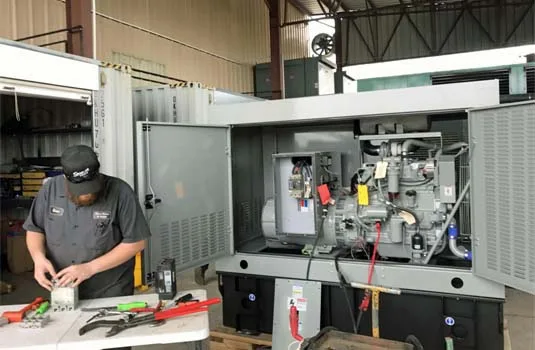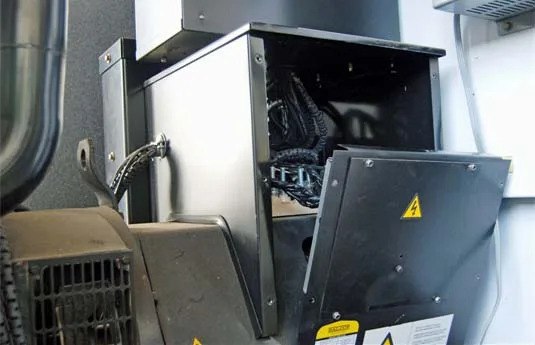Selecting the correct electrical configuration is essential when choosing a generator for your environment. This includes determining the appropriate phase, voltage, kilowatts (kW), and hertz for your specific application. A generator set (genset) consists of two primary components: an industrial engine and a generator end. The engine produces horsepower and RPM, which the generator end converts into electricity.
Phases in Industrial Generators
Single-Phase Generators
- Used for smaller single-phase loads.
- Common in residential environments.
- Typically do not exceed 40 kW.
- Power factor: 1.0.
Three-Phase Generators
- Designed for larger industrial power needs.
- Can support both single-phase and three-phase loads.
- Suitable for running high-horsepower industrial motors and distributing power across multiple lines.
- Power factor: 0.8.
Adjusting Power Output with Phases
Increasing Power Output Rating
- Converting single-phase to three-phase can increase kW output by 20–30%.
- Requires a reconnectable generator end and proper load balancing.
De-Rating (Three-Phase to Single-Phase)
- Reduces kW output by approximately 30%.
- Example: A 100 kW three-phase generator will de-rate to about 70 kW in single-phase.
Key Considerations for De-Rating
- Calculate adjusted power from kVA rather than kW using this formula:
Adjusted Power = (2/3) × kVA
Example: A 150 kVA single-phase generator de-rates to 100 kVA. - The generator end must typically have 10 or 12 reconnectable leads.
- Ensure individual line amps do not exceed the rated capacity when using single-phase loads.
Voltage Options for Commercial Generators
Single-Phase Voltages
- 120
- 240
- 120/240
Three-Phase Voltages
- 208
- 120/208
- 240
- 480 (most common for industrial gensets)
- 277/480
- 600 (common in Canada)
- 4160 Volt
Additional Voltage Options
- Includes uncommon voltages like 220, 440, 2400, 3300, and up to 13,500.
Determining the Required Voltage

Key Factors to Evaluate
- Incoming Voltage: Voltage from the mains transformer to the building.
- Maximum Amperage: Required to power your specific equipment.
- Startup Amperage: For industrial motors with high initial power demands.
- Utility Frequency:
- 60 Hz: Common in the U.S. and parts of Asia.
- 50 Hz: Standard in most other regions.
- 400 Hz: Specialized for large ships and airplanes.
Consulting Professionals
- An electrician or electrical contractor can help assess your facility’s needs.
- Use tools like power calculators and amperage charts for additional accuracy.
Adjusting the Voltage of a Generator

Overview
Voltage adjustments involve reconfiguring leads on the generator end. Most three-phase generators have 10 or 12 leads that can be rearranged to achieve different voltage combinations.
Common Adjustments
- Examples include converting 208V to 480V or 480V to 240V.
- Achievable if the generator end is reconnectable.
Considerations
- Specialized high-voltage gensets (e.g., 13,500 Volt) are less practical for alterations.
- Some systems may require significant rewiring, and certain generator ends are not reconnectable.
Additional Component Adjustments
Gauges
- Older generators may require gauge replacements to reflect new output levels.
- Digital control panels on modern gensets can often be reprogrammed.
Circuit Breakers
- Updated to match new amperage requirements.
- Configurations can vary (e.g., single 1200 Amp breaker or two 600 Amp breakers).
Voltage Regulators
- Adjustments to sensing wires are critical to avoid damage.
- Modern regulators are integrated into control panels, simplifying changes but increasing costs.
Transformers
- May need rewiring to support the new voltage configuration.
Automatic Transfer Switch (ATS)
- Amperage adjustments ensure smooth transitions during utility outages.
Understanding and configuring phase and voltage options for industrial generators is a technical process that requires careful evaluation and expertise. For complex adjustments or questions about your specific environment, consult a professional technician or commercial electrician. Contact us at 800-853-2073 or through our online form for assistance with sizing, configuring, or altering generator setups.